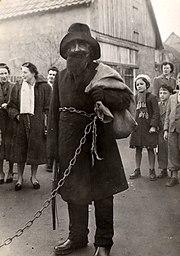....I forgot to add these other pagan and cultural bogies that are similar to or who have been associated with St Nick since the assimilation of culture and history began to be merged into one idea.
 http://en.wikipedia.org/wiki/Le_P%C3%A8re_Fouettard">Le Père Fouettard
http://en.wikipedia.org/wiki/Le_P%C3%A8re_Fouettard">Le Père Fouettard (French for The whipping Father) is a character who accompanies St. Nicholas in his rounds during St. Nicholas' Day (6th December) dispensing lumps of coal and/or floggings to the naughty children while St. Nick gives gifts to the well behaved.

A
http://en.wikipedia.org/wiki/Jultomten">Tomte (Swedish pronunciation: <ˈtɔ`mːtɛ>) or nisse (pronounced <ˈnìsːɛ>) is a mythical creature of Scandinavian folklore. Tomte or Nisse were believed to take care of a farmer's home and children and protect them from misfortune, in particular at night, when the housefolk were asleep.]
 http://en.wikipedia.org/wiki/Belsnickel">Belsnickel
http://en.wikipedia.org/wiki/Belsnickel">Belsnickel is the fur-clad Santa of the Palatinate (Pfalz) in northwestern Germany along the Rhine, the Saarland, and the Odenwald region of Baden-Württemberg. In Pennsylvania Dutch communities, it is also a mythical being who visits children at Christmas time.
 http://en.wikipedia.org/wiki/Perchta">Perchta or Berchta
http://en.wikipedia.org/wiki/Perchta">Perchta or Berchta (English: Bertha), also commonly known as Percht and other variations, was once known as a goddess in Southern Germanic paganism in the Alpine countries. Her name means "the bright one" (Old High German beraht, bereht, from a Common Germanic *berhto-, ultimately root-cognate to Latin flagrare "blaze", flamma "flame") and is probably related to the name Berchtentag, meaning Epiphany. Perchta is often identified as stemming from the same Germanic goddess as Holda and other female figures of German folklore (see Frija-Frigg). According to Jacob Grimm and Lotte Motz, Perchta is Holda's southern cousin or equivalent, as they both share the role as a "guardian of the beasts" and come during the Twelve Days of Christmas when they check on the spinning.
 http://en.wikipedia.org/wiki/Krampus">Krampus
http://en.wikipedia.org/wiki/Krampus">Krampus or otherwise known as "Krotchus" in the U.S. is a mythical creature who accompanies Saint Nicholas in various regions of the world during the Christmas season, especially Austria. The word Krampus originates from the Old High German word for claw (Krampen). In the Alpine regions, Krampus is represented by an incubus-like creature. While Saint Nicholas gives gifts to good children, the Krampus warns and punishes bad children.